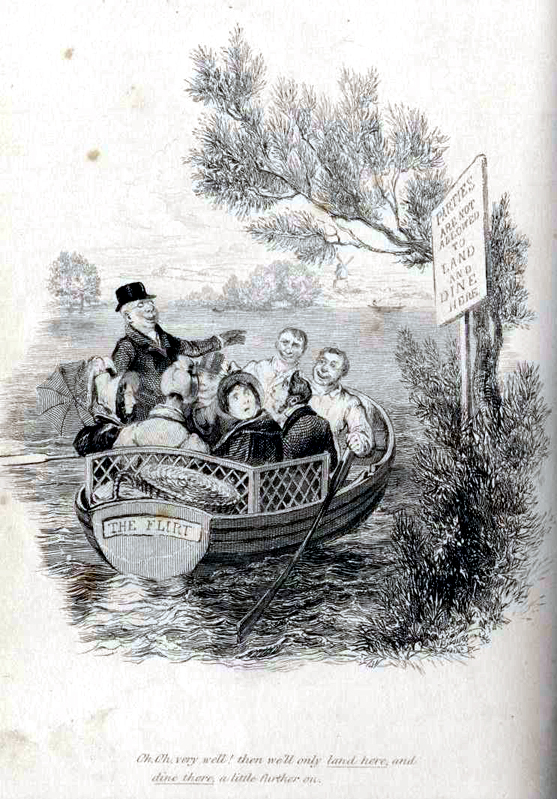Seymour’s picnics are comic as in Unpacking for a Pic-Nic and “—A merry holiday party, forming a tolerable boat-load, and well provided with baskets of provisions, were rowing along the beautiful and picturesque banks that fringe the river’s side near Twickenham, eagerly looking out for a spot where they might enjoy their “pic-nic” to perfection.”
Alfred Crowquill, aka Alfred Henry Forrester, added narrative to fill out the illustration, usually adding substantial humor as the boating party eagerly looking for a great place to picnic and finding a keep-out sign instead. Seymour’s legend is “—A merry holiday party, forming a tolerable boat-load, and well provided with baskets of provisions, were rowing along the beautiful and picturesque banks that fringe the river’s side near Twickenham, eagerly looking out for a spot where they might enjoy their “pic-nic” to perfection.” Crowquill’s 1838 suggests that determined picnickers will not be deterred by a “sign”:
“PARTIES ARE NOT ALLOWED TO
LAND AND DINE HERE”
Oh! oh! very well; then we’ll only land here, and dine a little further on.””
“What a repulsive board”-cried the young lady-“I declare now I’m quite vex’d.”
“Never mind, Julia, we won’t be bored by any board”-said the jocose old gentleman.
“I’m sure, uncle”-said one of the youths-“we don’t require any board, for we provide ourselves.”
“You’re quite right, Master Dickey,” said his uncle; “for we only came out for a lark, you know, and no lark requires more than a little turf for its entertainment; pull close to the bank, and let us land.”
“Oh! but suppose,” said the timid Julia, “the surly owner should pounce upon us, just as we are taking our wine?”
Why then, my love,” replied he, “we have only to abandon our wine, and, like sober members of the Temperance Society-take water.”
Pulling the wherry close along side the grassy bank, and fastening it carefully to the stump of an old tree, the whole party landed.
“How soft and beautiful is the green-sward here,” said the romantic Julia, indenting the yielding grass with her kid-covered tiny feet; “Does not a gentleman of the name of Nimrod sing the pleasure of the Turf?” said Emma: “I wonder if he ever felt it as we do?”
“Certainly not,” replied Master Dickey, winking at his uncle; “for the blades of the Turf he describes, are neither so fresh nor so green as these; and the ‘stakes’ he mentions are rather different from those contained in our pigeon-pie.”
“But I doubt, Dickey,” said his uncle, “if his pen ever described a better race than the present company. The Jenkins’s, let me tell you, come of a good stock, and sport some of the best blood in the country.”
“Beautiful branches of a noble tree,” exclaimed Master Dicky, “but, uncle, a hard row has made me rather peckish; let us spread the provender. I think there’s an honest hand of pork yonder that is right worthy of a friendly grasp;-only see if, by a single touch of that magical hand, I’m not speedily transformed into a boat.”
“What sort of a boat?” cried Julia. “A cutter, to be sure,” replied Master Dicky, and laughing he ran off with his male companions to bring the provisions ashore.
Meanwhile the uncle and his niece selected a level spot beneath the umbrageous trees, and prepared for the unpacking of the edibles.
Featured Image: Robert Seymour. “The Pic-Nic: Oh! oh! very well; then we’ll only land here, and dine a little further on.” (1834/36), in The Sketches of Seymour—Complete (London: Thomas Fry, after 1838). http://www.gutenberg.org/files/5650/5650-h/5650-h.htm.
See Robert Seymour. The Pic-Nic I: Oh! oh! very well; then we’ll only land here and dine a little further on.” The Sketches of Seymour—Complete (1834/36) (London: Thomas Fry, after 1838). http://www.gutenberg.org/files/5650/5650-h/5650-h.htm. This edition is based on a collection of Seymour’s works to which Alfred Crowquill, the pseudonym of Alfred Henry Forrester, added narrative and doggerel verse. Seymour wrote legends for each illustration, but Crowquill greatly expanded Seymour’s intention. See: Seymour’s Sketches / with Illustrations in Prose and Verse by Alfred Crowquill; Engraved on Steel by Henry Wallis, from the Original Drawings of the Late Robert Seymour (London: Joshua Thompson, 1838)

